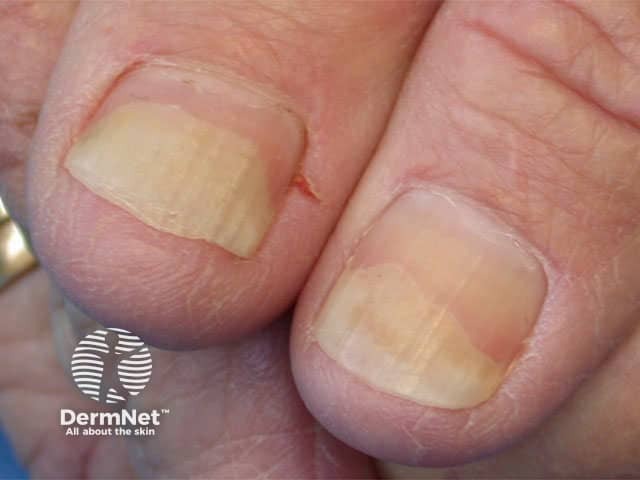Main menu
Common skin conditions

NEWS
Join DermNet PRO
Read more
Quick links
Authors: Vanessa Ngan, Staff Writer, 2003. Updated: Dr Fleur Weiqian Kong, Honorary Dermatology Registrar, Mater Adult Hospital, Brisbane QLD, Australia; Dr James Muir, Dermatologist, Mater Adult Hospital, Brisbane QLD, Australia. Copy edited by Gus Mitchell. December 2020.
Introduction Demographics Causes Clinical features Complications Diagnosis Differential diagnoses Treatment Outcome
Onycholysis is a common nail disorder in which the nail plate has separated from the nailbed typically resulting in a well-defined area of white opaque nail. It may be idiopathic or secondary to trauma, skin disease, nail infections, tumours, or systemic events. Photo-onycholysis is due to ingestion of a photosensitiser, such as a medication [see Drug-induced photosensitivity].


Idiopathic causes

Photo-onycholysis
Onycholysis can affect both sexes, all ages and races. It is most frequently seen in adult women.
Onycholysis can be primary (idiopathic, unknown cause) or secondary to one of many causes. Some examples are listed in Table 1.
Cause |
Examples |
Traumatic |
Repetitive trauma, including manicure |
Skin disease |
|
Infection |
Dermatophytes and yeasts eg, T. rubrum, C. albicans |
Systemic disease |
Endocrine eg, hypo- and hyperthyroidism, diabetes mellitus, pregnancy |
Medication |
Drug-induced photosensitivity eg, antibiotics including tetracyclines, NSAIDs, psoralens, and oral retinoids |
Others |
Hereditary distal onycholysis (MIM 164800) |
Onycholysis can affect a single nail or multiple fingernails and/or toenails. The distal part of the nail is most commonly affected lifting the free edge; sometimes the nail may detach laterally or proximally. Oil spot sign is an island of onycholysis under a nail.
Clinical features can include the following signs.

Psoriatic onycholysis

Nail lichen planus: onycholysis seen in 3rd and 5th fingernails

Onycholysis in psoriatic nail dystrophy
Onycholysis predisposes to secondary infection under the nail, most commonly with Candida albicans and Pseudomonas aeruginosa, resulting in discolouration of the nail.
Onycholysis can be cosmetically unacceptable, especially for people who work with their hands in public view.

Candida infection and onycholysis

C. albicans infection and onycholysis

Pseudomonas infection and onycholysis
Onycholysis is a clinical diagnosis with the cause often obvious on history and examination. Investigations may be required if the cause is not apparent.
Onycholysis may persist or progress due to:
Onycholysis should be distinguished from leukonychia (white nail), including Terry nail, in which the nail remains attached but appears white and opaque.
The detached portion of the nail will not reattach. The aim of treatment is for the new nail growth to remain attached to the underlying nailbed.
Specific treatment of onycholysis depends on the cause. This may mean ceasing or changing a medication, specific treatment of a nail infection, or appropriate treatment for an associated systemic condition or dermatosis.
Onycholysis of short duration and of known origin can recover with appropriate treatment. Fingernails take 4–6 months to fully regrow; toenails take twice as long. The longer onycholysis persists the less likely new nail growth will reattach due to permanent damage (cornification) of the underlying nailbed (‘disappearing nailbed’).